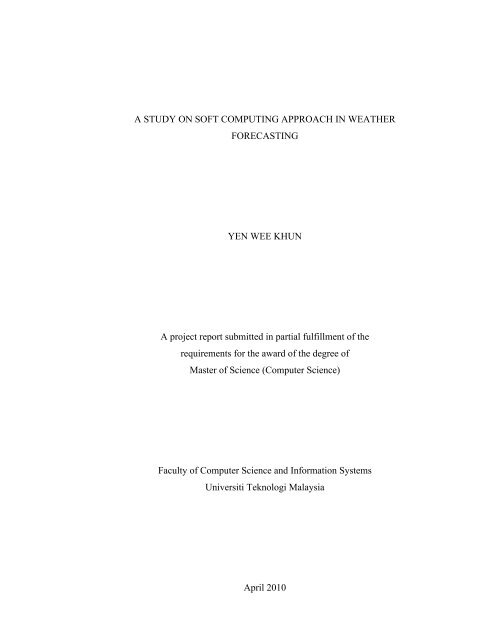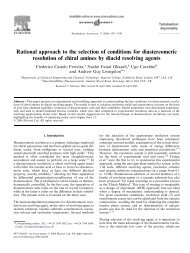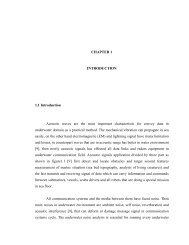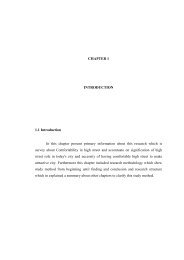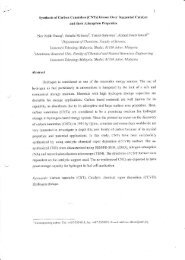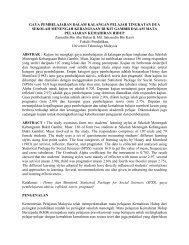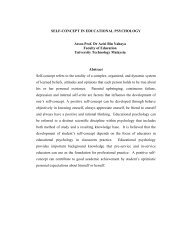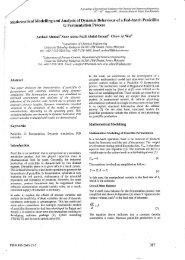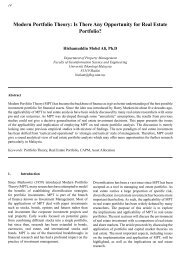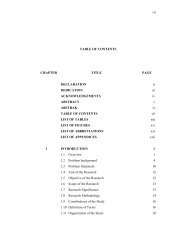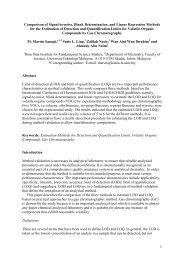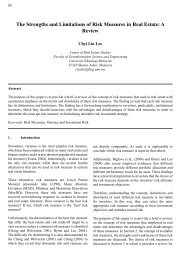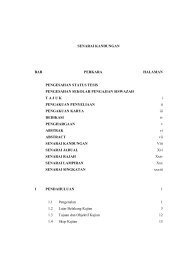A STUDY ON SOFT COMPUTING APPROACH IN WEATHER ...
A STUDY ON SOFT COMPUTING APPROACH IN WEATHER ...
A STUDY ON SOFT COMPUTING APPROACH IN WEATHER ...
You also want an ePaper? Increase the reach of your titles
YUMPU automatically turns print PDFs into web optimized ePapers that Google loves.
A <strong>STUDY</strong> <strong>ON</strong> <strong>SOFT</strong> <strong>COMPUT<strong>IN</strong>G</strong> <strong>APPROACH</strong> <strong>IN</strong> <strong>WEATHER</strong><br />
FORECAST<strong>IN</strong>G<br />
YEN WEE KHUN<br />
A project report submitted in partial fulfillment of the<br />
requirements for the award of the degree of<br />
Master of Science (Computer Science)<br />
Faculty of Computer Science and Information Systems<br />
Universiti Teknologi Malaysia<br />
April 2010
ACKNOWLEDGEMENT<br />
First of all, I would like express my gratitude to God who had given me the<br />
strength and patience to complete this project. I would also like to thank my beloved<br />
parents for their unlimited support. I wish to express my sincere appreciation to my<br />
thesis supervisor, Assoc. Prof. Dr Siti Zaiton Mohd Hashim who has been very<br />
patient in giving me encouragement, guidance, critics and friendship throughout the<br />
process of the project. Besides this, I would like to say thanks to Pn Lijah Rosdi who<br />
always patiently gives help to me. Without her continuous encouragement and help,<br />
this thesis would not have been smooth in the process. Last, my sincere appreciation<br />
also extends to all my friends who have provided assistance, motivation and inspiration<br />
whenever I have difficulties in this project.<br />
iv
ABSTRACT<br />
Weather forecasts based on temperature, wind speed and relative humidity<br />
are very important attributes in agriculture sector as well as many industries which<br />
largely depend on the weather condition. Therefore, having accurate weather<br />
forecasting information may allow farmers to make good decision on managing their<br />
farm. Soft computing is an innovative approach to construct computationally<br />
intelligent systems that are supposed to processes humanlike expertise within a<br />
specific domain, adapt themselves and learn to do better in changing environments,<br />
and explain how they make decisions. The weather forecasting model based on soft<br />
computing is easy to implement and produces desirable forecasting result by training<br />
on the given dataset. The technique of soft computing such as BPNN, RBFN,<br />
PS<strong>ON</strong>N and ANFIS are used in this study to test the performance in order to<br />
investigate which technique for weather forecasting is most effective and least of<br />
error. 720 hours of Johor Bahru weather data are used in this study in order to test<br />
their result of prediction based on MSE and RMSE. Besides, the experiment<br />
regarding the effect of different input nodes which applies tapped delay line method<br />
and different hidden nodes are also used to investigate whether previous data affects<br />
the performance. The result shows that ANFIS with input temperature, humidity,<br />
wind speed, weather condition(t), and weather condition(t-1) with the previous data<br />
will give the lowest MSE and RMSE, 7.0853e-3 and 8.4174e-2 consequence than<br />
other soft computing approaches.<br />
v
ABSTRAK<br />
Ramalan cuaca memainkan peranan yang penting kepada beberapa sektor<br />
industri terutamanya dalam sektor pertanian yang sangat dipengaruhi oleh keadaan<br />
cuaca. Oleh itu, mempunyai ketepatan mengenai maklumat ramalan cuaca mampu<br />
membolehkan pekebun menentukan dan menguruskan kebun mereka dengan lebih<br />
baik dan berkesan. Pengkomputeran lembut adalah sebuah pendekatan inovatif<br />
untuk membangun sistem komputasi yang cerdas seperti otak manusia dalam<br />
domain yang spesifik, senang menyesuaikan diri dan belajar untuk memperbaikkan<br />
diri dalam perubahan lingkungan, serta menjelaskan bagaimana mereka membuat<br />
keputusan. Teknik pengkomputeran lembut seperti rangkaian neural Algoritma<br />
Rambatan Balik (ARB), RBFN, rangkaian neural Pengoptima Partikal Berkelompok<br />
(PPB) dan ANFIS telah digunakan dalam kajian ini untuk menguji prestasi<br />
peramalan cuaca sama ada peramalan cuaca akan menjadi lebih berkesan, kurang<br />
keralatan atau tidak. 720 jam cuaca Johor Bahru digunakan dalam kajian ini dengan<br />
tujuan untuk menguji prestasi peramalan cuaca berdasarkan Ralat Min Kuasa Dua<br />
(RMKD) dan Ralat Min Punca Kuasa Dua (RMPKD). Selain itu, eksperimen<br />
mengenai nodus input yang berbeza dengan menggunakan teknik menoreh<br />
melambatkan kaedah garisan dan perbezaan nodus tersembunyi juga akan disiasat<br />
supaya dapat mengetahui sama ada data sebelumnya menpengaruhi keputusan<br />
output atau tidak. Hasil keputusan tersebut telah menunjukkan bahawa ANFIS<br />
dengan input suhu, kelembaban, kecepatan angin, keadaan cuaca(t) dan keadaan<br />
cuaca(t-1) memberikan RMKD dan RMPKD yang terendah iaitu 7.0853e-3 dan<br />
8.4174e-2 berbanding dengan pendekatan pengkomputeran lembut yang lain.<br />
vi


